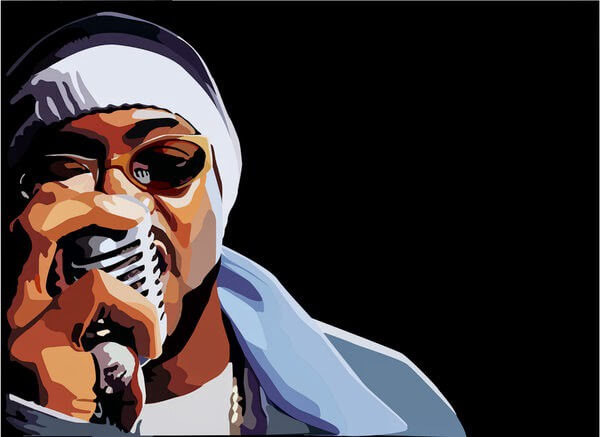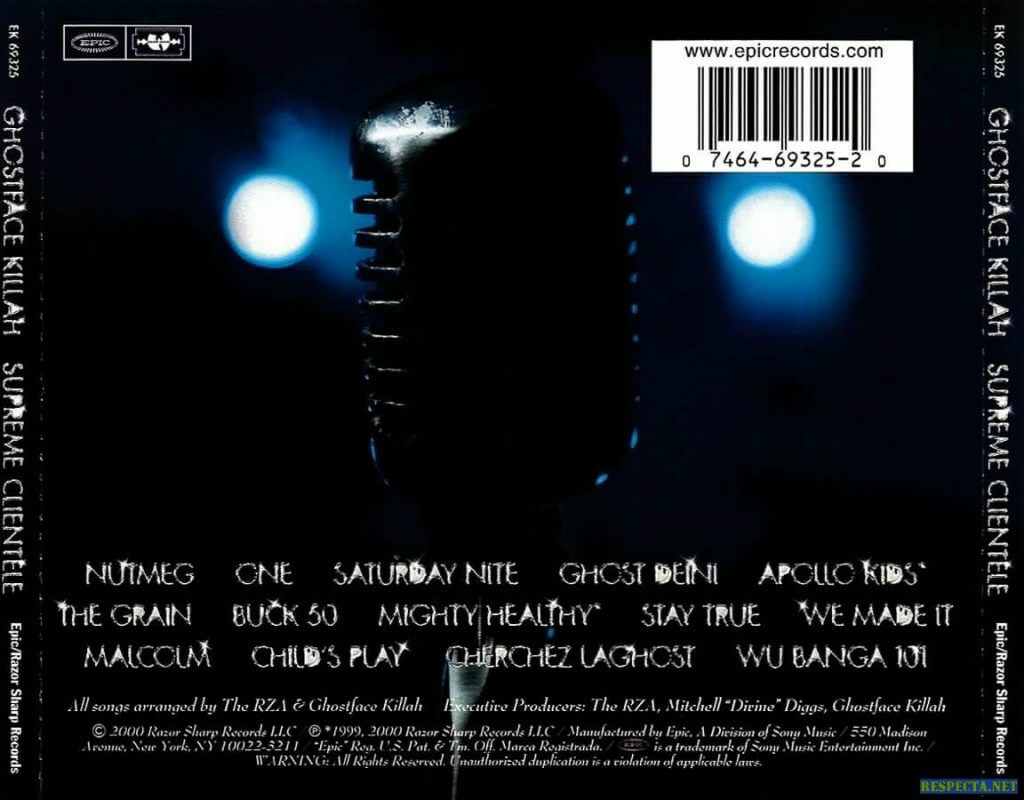With his sophomore disc, Ghostface Killah threw the Clan on his back and reached his apotheosis

“Walk with me like Dorothy”
It was over.
Three years after the Wu-Tang Clan had stood astride the music world with their sprawling and complex double album — the culmination of a half-decade of rap dominance in which five solo albums that each fell somewhere between superior and all-time classic were bookended by two legendary group albums — the crew endured its first slump.
With his five-year plan complete, RZA took a much-needed and much-deserved break from overseeing all aspects of the Wu world following Wu-Tang Foreverand ceded control to the artists themselves and other members of his organization.
The post-Forever period saw seven of the nine Clansmen — Method Man, RZA, GZA, Ol’ Dirty Bastard, Inspectah Deck, U-God, Raekwon — as well as quasi-member Cappadonna release a solo album in either 1998 or 1999. While there were some bright spots to be found, the second round of individual Wu albums were largely disappointing when compared to the lofty expectations set by the original wave of releases.
The two members that didn’t release anything in ’98 or ‘99? One was Masta Killa, who would not have an album to his name until 2004 when he dropped the highly underrated No Said Date.
The other was cooking, it was simply delayed a bit and that was probably a blessing.
On February 8th, 2000, Ghostface Killah released Supreme Clientele, an instant classic that was easily the best Wu album of that period, one that delivered a much-needed win for the group and helped to lay the groundwork for The W, the group’s last potent project as a collective.
As the late, great Sean Price once explained:
“You gotta remember, people were counting out the Wu by the time Supreme Clientele came out. He brought some light into the crew with that album. It’s a big album, an important album in the [Wu] catalog.”
At that moment, Ghostface threw the Clan on his back and carried them.
While stationed in West Africa to help him with his diabetes and other health problems, Ghostface began penning rhymes. When he returned to New York City, he began recording and not even a fourth-month bid on Rikers Island could take him out of the zone. The straightforward album cover represented what the world was about to hear: Ghostface bear-hugging the mic.
His pen game was on another level. While there were glimpses on Only Built 4 Cuban Linx… and Ironman, Ghostface (and partner-in-rhyme Raekwon) brought his stream-of-consciousness style front and center on Wu-Tang Forever before taking it to its absolute apex on Supreme Clientele.
The album is littered with rhymes that only Ghostface could conjure, such as visions of Queen Elizabeth wearing a ketchup-stained dress and rubbing his leg while they attended the opera, dancing with the Golden Girls (“Blanche and them bitches”), his d*** being featured on the cover of a magazine, and even sexing Oprah. He not only put “Supercalifragilisticexpialidocious” in a rhyme, but doubled down by immediately spitting it backwards, “Dociousaliexpi-fragilistic-cali-super.”
In true turn-of-the-century rap style it contains twenty-one tracks, but it retains its force throughout, ranging from the rewind-inducing brilliance of “One,” the crackling rawness of “Mighty Healthy” that is so vivid you can practically see the dust on the records, RZA’s epic verse on “The Grain,” the frenetic mic-trading on “Buck 50” that features an all-time classic Redman line (“Your weed got more seeds than ODB”), and the powerful complexity of “Malcolm.” Moreover, unlike many releases at the time, the skits were not only funny (“Kim or Fox?”) but also actually served a purpose to bring some levity to the proceedings.
When studying the greatest Wu-Tang albums of all time, the one constant is the presence of the Abbot and Supreme Clientele is no exception.

via Christopher Pierznik
Ghost’s energetic rhymes and unique approach were indispensable, of course, but RZA was integral in pushing the disc to the next level. He had taken a hands-off approach to the other albums, contributing one or two beats at most while directing members to utilize other producers and executives:
“I ain’t been wit anyone but Ghost and my C-artists for almost two years. I assigned Power to Rae[kwon] and [Inspectah] Deck. I assigned Divine to Meth[od Man] and Cappadonna. I said, ‘I’ma rock me, Ghost, and U-God.’ Basically we broke the s*** down on purpose.”
Bonanno, Jonathan, “Return of the Dragon,” The Source, March, 2000. pp. 207–208
This led to some in the hip-hop world to begin sleeping on his brilliance, but he called not only executive produced and oversaw Ghostface’s entire project, the two of them reworked every beat, even those on which neither is the credited producer:
“On Ghost’s album, production is credited to the RZA and Ghostface. We got beats from Carlos Broady, JuJu of the Beatnuts, Hassan of UMC’s, Mo the Barber, and Black Moes-Art. The bottom line is we compiled it. After the n — as gave us a beat, we never seen ’em again. Usually a producer he comes in, he makes the beat, he mixes it, he guides the path of it. But nobody really did that for this album with me and Ghost. That’s why you get that special sound. I chose all the music for the skits and everything. I just needle and threaded it together.”
Bonanno, Jonathan, “Return of the Dragon,” The Source, March, 2000. pp. 208

The 4.5 mic review (back when it meant something) via Christopher Pierznik
Put another way:
“The common denominator was the RZA. He assembled and mixed them, adding uniform layers of grime and radioactivity, bizarre alarms and a dense twisted paranoia. It’s soul music transmogrified into gleaming metal, a tank covered in diamonds. The instrumentals sound like they’re ranting right back at Ghost, who sounds like he’s dripping blood onto the mic stand.”
From the simple wickedness of the repeated backwards scratch on “Stroke of Death,” to the exultant mood of “We Made It,” and the classic Shaolin sound on the posse cut “Wu Banga 101,” the sounds and approaches vary, but the quality remains extremely high throughout.
The practice of taking classic soul samples and polishing them while simultaneously making them grittier influenced the production style of many, including the old Kanye and the voices on the album sound like otherworldly members of Ghostface’s crew, hyping him up and encouraging him to keep rhyming his a** off. It’s one of those rare instances when the beats and rhymes fit together perfectly.
Forget best-of-the-year album lists, Supreme Clientele was mentioned on numerous best albums of the decade lists but such outlets as The A.V. Club (#28), Pitchfork (#11), and Complex (#8).
“Supreme Clientele possesses two things significantly absent from recent Wu projects: an increased number of cameos from his Wu-Tang breathren and RZA overseeing the production and final mix down. The ‘Iron Man’ cartoon skits, Rakewon’s two appearances, and posse cuts like ‘Wu Banga 101’ take the album back tot he original essence that made the Clan stand out.”
Bonanno, Jonathan, “Last Man Standing,” The Source, March, 2000. pp. 215
It’s a classic Wu-Tang album in other ways too: the tracklist on the back cover was all wrong, just like on GZA’s Liquid Swords or Ghost’s own debut, Ironman. In an era when the Clan was maturing, growing, and expanding, becoming more corporate and polished, more acceptable to the mainstream, it was a refreshing reminder of what once was. Sometimes imperfection can be perfect. Following Enter the Wu-Tang (36 Chambers), Dennis Coles removed the mask and began to show us more of himself, first as he rode shotgun on a classic that defined a subgenre and then while revealing his humanity on his own debut, but this album saw him reach his full apotheosis as a rap superhero wearing valor robes down to the floor.
Over the next two decades, Ghostface Killah would prove himself to be Wu-Tang’s most consistent member and he first separated himself with Supreme Clientele.
Republished from https://christopherpierznik.com/2020/02/07/still-supreme-after-two-decades/
Christopher Pierznik’s is the worst-selling author of nine books. Check out more of his writing at Medium. His work has appeared on XXL, Cuepoint, Business Insider, The Cauldron, Fatherly, Hip Hop Golden Age, and many more. Subscribe to his monthly newsletter or follow him on Facebook or Twitter. Please feel free to get in touch at CPierznik99@gmail.com.

I run internet radio station Phat Beats Radio https://phatbeatsradio.com/ playing the best Rap Hiphop R&B Soul Funk Reggae Chillhop Acid Jazz from the 1970s to early 2000s over 100k traxx in the playlist streaming from Columbia MO. Would you been willing to add a txt link or small banner of my station on your blog let me know my Skype DJboutit. You run a amazing old skool rap blog keep up the good work.